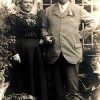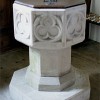St. Michael’s at Stinsford is often spoken of as “Hardy’s church,” a reference to Dorset’s most famous son; the novelist, poet and architect Thomas Hardy, who said, “I shall sleep quite calmly at Stinsford, whatever happens.”
The writer had discussed his funeral with Stinsford’s vicar the Rev. H.G.B. Cowley but when the time came the literati and establishment of the day had other plans for him. Hardy’s cousin, Theresa, told the press “I am grieved that they are going to take poor Tom away to London. He wanted, I know, to lie with his own folk in the churchyard yonder.” At the insistence of the great and good his ashes were buried at Poet’s Corner in Westminster Abbey, something Kate Hardy found “another staggering blow.” It was Cowley who proposed what someone at the time described as “a gruesome though historic compromise:” Thomas Hardy’s heart was removed to Stinsford and laid to rest with his first wife at exactly the same moment as his ashes were being interred at Westminster.
Hardy knew this place well. His parent’s worshipped here, he was baptised here, he was a Sunday school teacher here, and he buried his first wife here. Later after his death his second wife was buried here. As you enter the churchyard through the lych gate to your left there is a row of graves and memorials to Hardy and members of his family. Standing sentry at the end of this line is a modern slate marking the burial place of the Poet Laureate, Cecil Day Lewis, who passed away in 1972 and wished to be buried close to his mentor.
The map of the parish of Stinsford is a square plan representing some 3,300 acres. The parish is a union of the settlements of Bhompston, Bockhampton, Kingston, Stinsford and Coker’s Frome and it is likely they were in existence in 1086, but Frome Whitfield, which transferred to Stinsford parish from Dorchester Holy Trinity in 1894, is the only one to retain any trace of a mediaeval village.
St. Michael’s comprises a nave with north and south aisles, chancel with a north vestry off and a west tower. Built with roughly squared and coursed rubble, with ashlar dressings; the roofs are covered with slates, stone-slates and lead. The chancel and north and south arcades of the nave are of the early 13th century. The west tower was added in the 14th century and the west wall of the south aisle looks to have been rebuilt at this time. The south aisle is mainly 15th century and the north aisle was rebuilt in 1630 and again altered in the 19th century. The north vestry was added in 1868.
The font in which Hardy was baptised was moved to St. Luke, Stanmore, Winchester in 1948. Thomas Hardy discovered pieces of the original Norman Font in the churchyard, it was restored in 1920 and remains at St. Michael’s.
Restoration of churches was something the Victorians did, and on a vast scale. St. Michael’s received more than its deserved share of attention being restored in 1868, 1883 and later in 1910. During one of these restorations the musician’s gallery was removed against the wishes of the Hardy family, who had provided over the years many of the musicians who made up the church band; the family voiced its collective displeasure but to no avail.
In 1996 a new gallery and organ were installed, the result of the generosity of a Yale University professor Richard Purdy. The endowment was in commemoration of Florence Hardy, the novelist’s second wife.
The nave’s 16th century barrel roof was lost to the Victorian restorers but the chancel arch and the 17th century barrel vault roof, hagioscope and recess, which used to access a stairway to the rood screen survived.
The tower is home to three bells the first dated 1616; the second by Thomas Purdue is dated 1663 and a treble, originally of the 15th century but recast in 1927.
“Hardy’s Church” is the resting place for many others and there are memorials for William Obrien 1815: Susannah Sarah Louisa (Strangeways) Obrien 1827; Rev. William Floyer 1819; William Floyer R.N., 1822; and other members of that family; Marcia (Pitt) Cholmondeley 1808; George, Charles and John son of John and Marcia Pitt of Encombe; Audeley and Margaret (Trevelyan) Grey 1723; William Harding 1834, and Hannah his wife, 1841; Benjamin Bowring 1837; John 1693; and Mell Cox 1716 and William Cox 1704.
In the chancel there is a plaque to Wadham Strangeways 1685, killed at Bridport in the King’s service against Monmouth; also Elizabeth his wife 1683, and Rachel Radford her sister 1682.
Inside the church seems a lot smaller than it looks from the outside: it has a warm, comfortable, almost cosy feel. Hardy would have been pleased to see the gallery replaced though viewed from the chancel arch it looks jarringly modern and would have fitted in better had it been made from a darker or distressed timber.
Hardy had called God “that vast imbecility” so it must have been his sense of history and family rather than his faith that made St. Michael’s church so important to him.
There are photographs of the church and the Hardy memorials in the photo section.



